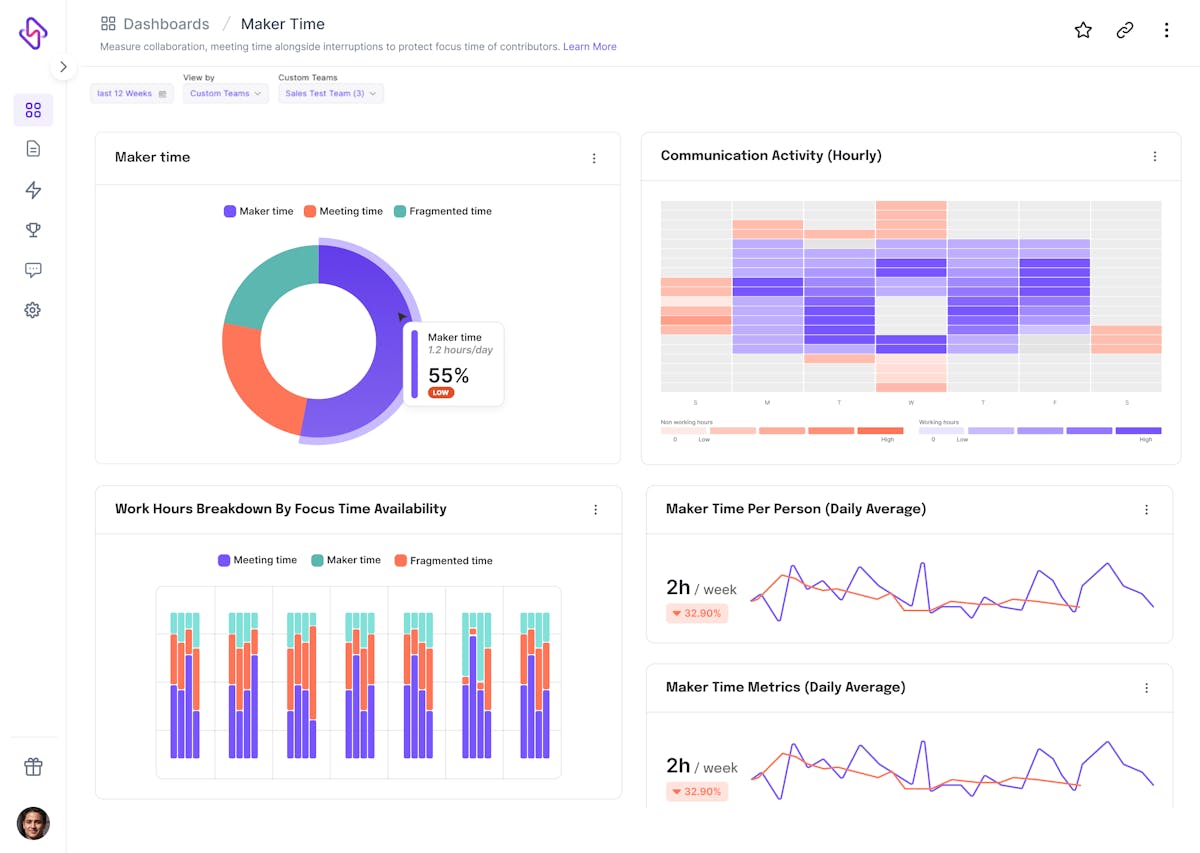Meeting creep is real- there’s no two doubts about that. As we keep on finding new avenues to connect, and work together in remote models, our calendars get crippled with numerous hour-long calls, and status updates, leaving little room for deep work.
PS: Not all meetings are inefficient, or unproductive; for most part of the last decade, they have served as an intersection of diverse ideas, inclusivity, and building powerful roadmaps for visionary products. Our focus is to cut down on data-deficient, insight-less meetings that derail engineering teams from doing their best work and delivering engineering excellence.
For engineering teams, one-third of meetings are nothing but a strain on their productivity- thanks to lack of workflow visibility and inability to indulge in data-driven conversations. Back to back context switching from one call to another puts developers in a tight spot, often sacrificing their active coding hours and grooming time.
We are not surprised that developers and engineering teams continuously complain about inability to focus on deep-work or get into the flow state. As of now, developers only code 33% of their time, with the major chunk going into attending meetings and other tertiary activities.
Did we also mention the toil of refocusing on your core items? Getting back to your deep work state requires atleast uninterrupted 25 minutes– a rare luxury in our present world of constant meeting creep.
This absence of contextual data during meetings restrains engineering teams from making a major impact at work. Developers frequently grapple with technostress and Zoom fatigue, often spiraling into chronic burnout, and even fueling (or having played its own sheer role) the Great Software Resignation.
The business impact of unproductive meetings is equally appalling. In the States alone, businesses lose around $37 billion to meeting creep.
Another report by Bloomberg shows how meeting fatigue costs $25,000 per employee– taking the annual figure to $101 million for large-sized engineering organizations. Shopify, the eCom giant was also quick to realize how unnecessary meetings were costing 320,000+ man hours, and millions of dollars. Now the company is devising ways to bring precision into meetings, while culling excess quantity.
Following the Shopify example, the future of meetings tied with engineering work doesn’t look as bleak as the present. It is not a challenge that cannot be fixed at all. Sigh!
The next great leap in meeting management is engineering analytics. And that is precisely where Hatica comes into play.
Armed with contextual data, and actionable insights, Hatica helps engineering teams reduce meeting FOMO, unclog calendars, and find their deep work state, all while reducing any developmental strains that can weigh down developers.
Here’s how Hatica tackles meeting creep for engineering teams:
1. Engineering Analytics to Run Powerful, and Productive Meetings
Meetings are a high-octane reminder that engineering leadership cares about every developer. Engineering 1:1s by managers equally contribute in understanding an IC’s work, invest in their growth, and flag workflow bottlenecks before they become emergencies.
Data’s role in leading engineering conversations is already much stated- It makes discussions twice as effective, while cutting efforts by 80%.
Hatica leverages this team data to run productive meetings. Here’s how we empower engineering teams in cutting unnecessary calls, and stay productive:
- Visualize engineering progress, and developer contributors to the overall development lifecycle, without any manual intervention, and need for constant status updates
- Run meaningful 1:1s that celebrate your engineering team’s efforts, balance investments, and work allocation, while staying on top of all your project deliverables
- Effective, and impactful cross-functional collaboration between product, and engineering teams. A 360 degree view into engineering efforts incentivizes PMs to align with engineering teams seamlessly, without constant back-and-forth during sprint planning meetings.
- Reduce data sprawl that might later spiral into information overlook, low engagement, and cognitive fatigue
- Create agenda-driven meetings fueled with traceable goals, actionable insights, and confidence to operate in face of adversities (Downtime, or security vulnerabilities)
- This data-driven visibility automatically eliminates excessive meetings by offering more context into engineering work, and empowering devs to work with autonomy, without micromanagement.
- Ultimately, the idea is for engineering leaders to move beyond guesswork, and work towards the larger picture– eliminate redundancies, and blockers in your SDLC.
With Hatica’s work analytics, it becomes easier for your team to reflect on short, and long-term progress, project vision, immediate goals, and roadmap for individual contributor’s growth. That way, you can easily acknowledge good work, celebrate impactful contributions, and reduce recency bias- all while streamlining developer workflow.
2. Async Standups To Reduce Meeting Overload
Standups are meant to remove development blockers, and flag team frictions. However, here’s a reality check: Over the last few years, standups have shrunk into just another status update meeting, with no real value to your engineering team.
The regular morning standups often come at the expense of:
- Deep work hours
- Undocumented, and monotonous updates
- Depersonalization of engineering bottlenecks
- The Brevity vs Detail dilemma where devs find it challenging to address blockers, and send updates– all in a few minutes span.
- Distorting the natural peak productivity hours of most of your ICs.
Majority of these standup calls are dominated by off-topic discussions, frequency overload, and ineffective communication- adding to one more ineffective meeting in your team’s calendar.
To overcome any, and every challenge posed by traditional standups, we are introducing our async standups.
Hatica was built by engineers for engineers, and truly understands the need, and necessities for developers. Our async standups serves as a powerful reminder of what engineering teams are capable to achieve when given autonomy to work without frequent interruptions.
Hatica check-ins equip engineering teams with workflow visibility, day to day action items, team pulse, and developer workload- all at a centralized space.






